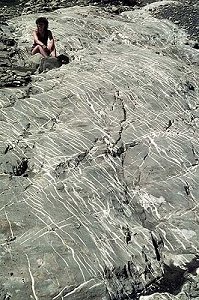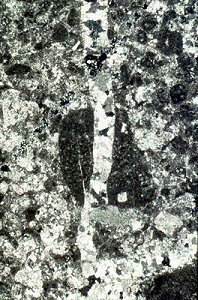
Vein arrays seen on a bedding surface
in Cretaceous limestones, Sdanetsch, Swiss Alps. These veins are filled
by new, bright white calcite.
Reprecipitation is an important part of the deformation process. There are several different sorts of site such as veins... which can occur on all scales.
 |
|
Vein arrays seen on a bedding surface
in Cretaceous limestones, Sdanetsch, Swiss Alps. These veins are filled
by new, bright white calcite.
|
They can often form across large parts of an outcrop ![]()
 |
|
Photomicrograph of a calcite vein developed
in a limestone, from the french Alps (Chartreuse area). This vein is about
100 microns across.
|
and be found in thinsection ![]() .
.
Veins are simply voids formed by dilatation created along fractures (commonly tensile fractures) into which has been precipitated new minerals - such as calcite or quartz.
 |
|
Photomicrograph of fibrous reprecipitation
of calcite around a "rigid" pyrite grain. These features are called pressure
shadows or pressure fringes. The calcite comes from the host rock which
has dissolved from the plane of vein. This material was collected from
strongly deformed Jurassic limestones, Beaufortain, NW French Alps.
|
But there are other forms of precipitation site such as pressure shadows ![]() .
.
There are also special vein arrays called tension gashes.